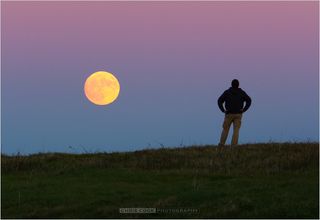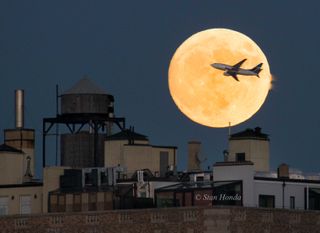Closest 'Supermoon' Since 1948 Thrills Skywatchers (Photos)

This month's full moon came the closest to Earth that it has been since 1948. Skywatchers and astrophotographers flocked to see the big, bright moon in all of its glory Sunday night (Nov. 13).
The full supermoon peaked this morning (Nov. 14) at 8:52 a.m. EST (1352 GMT), but it will still look "super" for about a day after its maximum. So if you haven't seen it yet, there's still some time to go check it out. [Supermoon November 2016: When, Where & How to See It]
But just in case you aren't able to see the supermoon, Space.com has you covered. You check out awesome photos of the supermoon by Space.com's superfans in our supermoon photo gallery.

Photographer Chris Cook took a self-portrait with what he called the "super-duper full moon" in the background on Sunday evening in Eastham, Massachusetts. Cook said that as the moon was rising, "it didn't look any bigger than other moonrises, but once it got higher in the sky later that night it did seem larger than a full moon at apogee," or the point in the moon's orbit at which it is farthest from Earth.

The difference in size between the supermoon and other full moons can be difficult to see — it only appears about 14 percent larger than usual. To offer some comparison with other full moons, photographer Bill Hood created the composite image that's shown above.
In some other photos, the supermoon did appear much larger than an ordinary full moon. With other objects serving as points of reference in a supermoon shot, the moon can look huge! [How to Photograph the Supermoon: NASA Pro Shares His Tips]

Photographer Stan Honda captured this photo of a WestJet airliner flying across the face of the supermoon after it took off from LaGuardia Airport in New York on Nov. 13. Honda took the photo from Central Park in Manhattan at 4:50 p.m. EST, while he was taking pictures of the moon along with members of the Amateur Astronomers Association of New York and students from his night-sky photography class.
Get the Space.com Newsletter
Breaking space news, the latest updates on rocket launches, skywatching events and more!
Honda said that he had not intended to take photos of airplanes when he set out to photograph the supermoon; timing was simply on his side. "The moon had just cleared the top of the building when I saw a plane flying towards the moon," he said. "I waited until the plane was just entering the disk and tripped the shutter."
Photographers waiting for a chance to get out and photograph another big and bright full moon need not wait long. December's full moon will also be "super" — albeit less super than November's full moon. [3 'Supermoons' for of 2016 - NASA Explains | Video]
Editor's note: If you have an amazing skywatching photo you'd like to share with Space.com and our news partners for a possible story or image gallery, please send your photos to our staff at spacephotos@space.com.
Email Hanneke Weitering at hweitering@space.com or follow her @hannekescience. Follow us @Spacedotcom, Facebook and Google+. Original article on Space.com.
Join our Space Forums to keep talking space on the latest missions, night sky and more! And if you have a news tip, correction or comment, let us know at: community@space.com.

Hanneke Weitering is a multimedia journalist in the Pacific Northwest reporting on the future of aviation at FutureFlight.aero and Aviation International News and was previously the Editor for Spaceflight and Astronomy news here at Space.com. As an editor with over 10 years of experience in science journalism she has previously written for Scholastic Classroom Magazines, MedPage Today and The Joint Institute for Computational Sciences at Oak Ridge National Laboratory. After studying physics at the University of Tennessee in her hometown of Knoxville, she earned her graduate degree in Science, Health and Environmental Reporting (SHERP) from New York University. Hanneke joined the Space.com team in 2016 as a staff writer and producer, covering topics including spaceflight and astronomy. She currently lives in Seattle, home of the Space Needle, with her cat and two snakes. In her spare time, Hanneke enjoys exploring the Rocky Mountains, basking in nature and looking for dark skies to gaze at the cosmos.
Most Popular


